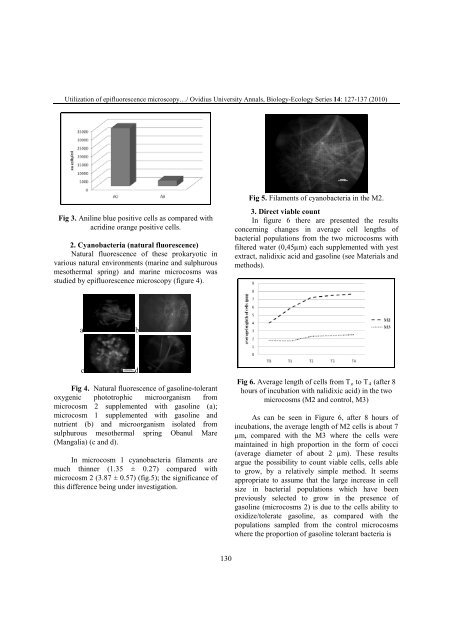VOLUM OMAGIAL - Facultatea de Ştiinţe ale Naturii şi Ştiinţe Agricole
VOLUM OMAGIAL - Facultatea de Ştiinţe ale Naturii şi Ştiinţe Agricole
VOLUM OMAGIAL - Facultatea de Ştiinţe ale Naturii şi Ştiinţe Agricole
Create successful ePaper yourself
Turn your PDF publications into a flip-book with our unique Google optimized e-Paper software.
Utilization of epifluorescence microscopy…/ Ovidius University Annals, Biology-Ecology Series 14: 127-137 (2010)<br />
Fig 3. Aniline blue positive cells as compared with<br />
acridine orange positive cells.<br />
2. Cyanobacteria (natural fluorescence)<br />
Natural fluorescence of these prokaryotic in<br />
various natural environments (marine and sulphurous<br />
mesothermal spring) and marine microcosms was<br />
studied by epifluorescence microscopy (figure 4).<br />
a b<br />
c d<br />
Fig 4. Natural fluorescence of gasoline-tolerant<br />
oxygenic phototrophic microorganism from<br />
microcosm 2 supplemented with gasoline (a);<br />
microcosm 1 supplemented with gasoline and<br />
nutrient (b) and microorganism isolated from<br />
sulphurous mesothermal spring Obanul Mare<br />
(Mangalia) (c and d).<br />
In microcosm 1 cyanobacteria filaments are<br />
much thinner (1.35 ± 0.27) compared with<br />
microcosm 2 (3.87 ± 0.57) (fig.5); the significance of<br />
this difference being un<strong>de</strong>r investigation.<br />
130<br />
Fig 5. Filaments of cyanobacteria in the M2.<br />
3. Direct viable count<br />
In figure 6 there are presented the results<br />
concerning changes in average cell lengths of<br />
bacterial populations from the two microcosms with<br />
filtered water (0,45µm) each supplemented with yest<br />
extract, nalidixic acid and gasoline (see Materials and<br />
methods).<br />
Fig 6. Average length of cells from To to T4 (after 8<br />
hours of incubation with nalidixic acid) in the two<br />
microcosms (M2 and control, M3)<br />
As can be seen in Figure 6, after 8 hours of<br />
incubations, the average length of M2 cells is about 7<br />
µm, compared with the M3 where the cells were<br />
maintained in high proportion in the form of cocci<br />
(average diameter of about 2 µm). These results<br />
argue the possibility to count viable cells, cells able<br />
to grow, by a relatively simple method. It seems<br />
appropriate to assume that the large increase in cell<br />
size in bacterial populations which have been<br />
previously selected to grow in the presence of<br />
gasoline (microcosms 2) is due to the cells ability to<br />
oxidize/tolerate gasoline, as compared with the<br />
populations sampled from the control microcosms<br />
where the proportion of gasoline tolerant bacteria is





